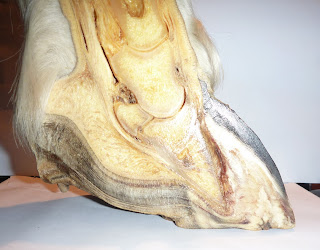 |
| 1. Very laminitic hoof - external side view note very high heel and almost horizontal hair line |
 |
| 2. Same hoof as 1. - internal side view (foot balance same) note how you can see how outer hoof wall has been heavily rasped. Note position and angle of pedal bone |
 |
| 4. Front foot of horse in 3. Again note heel height and hair line |
 |
| 5. Same horse as 3 and 4 - see how much excess height in heel |
 |
| 6. Compare with 4 note change in overall height |
 |
| 7. Compare with 3 - note change in heel height and change in angle of hair line |
The horse in pictures 3-7 had been on box rest, shod and lame for c. 9 months. His owner had done everything instructed and was finally told by her farrier to put the horse down as nothing more could be done.
So they tried one more thing - the barefoot approach. The shoes were removed, the heels brought down and the diet modified. Within two weeks the horse was sound enough to be racing around a track system.
The longer term recovery has been a learning curve for the owner as they learnt that no their horse can't eat haylage or a handful of pony nuts. But a year later and the horse is still sound and still bouncing around like a lamb and is now well enough to take a much more active role in life.
Long may this last.
I will leave you to draw your own conclusions about where the internal structures where in his hoof when the heels were so high. We can't proved anything as we don't have x-rays, but we do know that when the heels came down the horse came sound.









6 comments:
I have been researching the whys of employing shoes in the treatment of laminitis, as the idea just makes me scratch my head.
A common theme I found was simulating ground contact by filling the shoe with material. Why wouldn't you just be done with it and put the foot on the actual ground? Hoof wedges to relieve the DDFT?Why not just put the horse in deep round gravel and let the horse place his foot where it is comfortable instead of forcing the angle? Frog support? The ground does that for you!
That's it - I'm off to write a blog post on it I think! Glad this horse was brought back from the brink. :)
I have seen so much success in laminitis treatment with PROPER barefoot trimming. I would never try any other approach with my own boy.
All makes perfect sense, but why does it take so long for vets/farriers to catch on? When I was told by both to shoe my 3 year old unbacked cob as he was foot-sore, I looked for other ideas, and found the barefoot approach. The answer lie in diet and exercise and a decent trim and he went from a laminitic stance on a deep shavings bed, to rock crunching in about 10 days. One of his most comfy surfaces was a wet sand round pen. His feet loved the support of the moulding substrate.
Laura, where is the money for vets and farriers in healthy hooves? Where is the money in owner trimmers that are educated about diet? It is cheeky to say, but I'm afraid it is true.
I read yesterday somewhere that when bicycles were first invented, vets and farriers HATED them. They said it scared horses but really, vets couldn't treat a bike's ailments and farriers couldn't show a bike. Bikes didn't need hay or grain to be used each day and they were cheap.
Until the industry changes, until owners demand the absolute best for their horses from their hoof are professionals and vets, then they will continue spouting this dribble that a foundered horse NEEDS shoes.
(Little disclaimer here - I am not talking about every individual vet and farrier having a thirst for your money - there are individuals that truly do have the horse's best interest at heart and are pushing the boundaries. Those are the good ones, but probably the hated and poorer ones too!!)
Thanks so much for sharing this! if you don't mind, i would like to share this on my blog www.valheart.com/blogs
Hi Val - sure - just let peeps know where you found it! :-)
Post a Comment